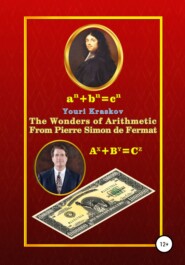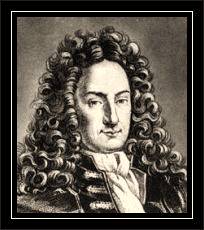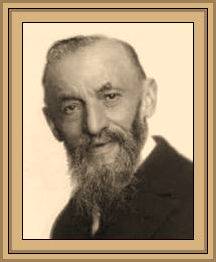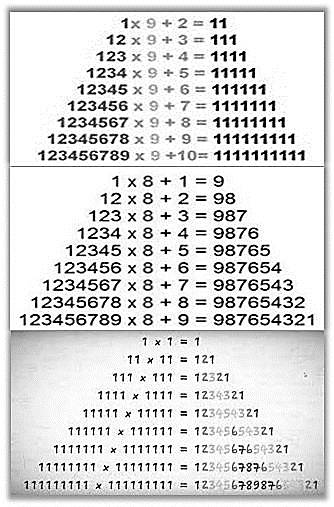
Полная версия:
The Wonders of Arithmetic from Pierre Simon de Fermat
Pic. 31. Gottfried Leibniz

All definitions of a number have one common basis:
Numbers exist objectively in the sense that they are present in the laws of the world around us, which can be known only through numbers.
From the school bench everyone will learn about numbers from the childish counting: one, two, three, four, five etc. Only the Lord knows where did this counting come from. However, there were attempts to explain its origin using axioms, but the origin of them is as incomprehensible as the counting. Rather, it looks like a certain imitation of the Euclid's "Elements" to add to knowledge the image of science and the appearance of solidity and fundamentality.
The situation is completely different when there is a mathematical definition the essence of a number. Then for a more complete understanding of it, both axioms and a countable quantity become a necessity. Indeed, this definition to the essence of a number includes arguments, actions and a countable quantity. But arguments are also numbers and they should be presented not specifically each of them, but by default i.e. in the form of a generally accepted and unchanged function, which is called the number system, however it no way could to appear without such a notion as a count. Now, axioms turn out to be very appositely and without them a count may be got only from aliens. In reality it was namely so happened since such sources of knowledge as the Euclid's “Elements” or the Diophantus' “Arithmetic” were clearly created not by our, but by a completely different civilization.35
If axioms regulate the count, then they are primary in relation to it. However, there is no need to determine their essence through the introduction of new notions because the meaning of any axioms is precisely in their primacy i.e., they are always essentially the boundaries of knowledge. Thus, axioms receive an even more fundamental status, than until now when they were limited only to the foundation of any separate system. In particular, the system of axioms, developed by the Italian mathematician Giuseppe Peano, very closely correspond to the solution of the problem for constructing a counting system although this main purpose was not explained apparently with a hint on justification the essence the notion of number. The scientific community perceived them only as a kind of “formalization of arithmetic” completely not noticing that these axioms in no way reflect the essence of numbers, but only create the basis for their presentation by default i.e. through a count.
If the main content of axioms is to determine the boundaries of knowledge related to generally accepted methods of representing of numbers, then they should be built both from the definition the essence of the notion of number and in order to ensure the strength and stability of the whole science's building. Until now, due to the lack of such an understanding of the ways of building the foundations of knowledge, the question about the essence of numbers has never even been asked, but only complicated and confused.
Pic. 32. Giuseppe Peano

However, now when it becomes clearer and without any special difficulties, all science can receive a new and very powerful impetus for its development. And then namely on such a solid basis, science acquires the ability to overcome with an incredible ease such complex obstacles, which in the old days, when there was no understanding the essence of numbers, they seemed to science as completely impregnable fortresses36.
3.2. Axioms of Arithmetic
3.2.1. Axioms of a Count
This path was first paved at the end of the 19th century by Peano axioms.37 We will make changes to them based on our understanding the essence of the number.
Axiom 1. A number is natural if it is added of units.38
Axiom 2. The unit is the initial natural number.
Axiom 3. All natural numbers form an infinite row, in which each
following number is formed by adding unit to the previous number.
Axiom 4. The unit does not follow any natural number.
Axiom 5. If some proposition is proven for unit (the beginning of
induction) and if from the assumption that it is true for a natural
number N, it follows that it is also true for a natural number
following N (induction hypothesis), then this sentence will be true
for all natural numbers.
Axiom 6. In addition to natural numbers, there can exist another
numbers derived from them, but only in the case if they possess all
without exception the basic properties of natural numbers.
The first axiom is a direct consequence from definition the essence of number, so Peano simply could not have it. Now this first axiom conveys the meaning of defining the notion of number to all another axiom. The second, fourth, and fifth axioms are preserved as in Peano version almost unchanged, but the fourth axiom of Peano is completely removed from this new system as redundant.
The second axiom has the same meaning as the first one in the Peano list, but is being specified in order to become a consequence of the new first axiom.
The third axiom is the new wording of Peano's second axiom. The notion of the natural row is given here more simply than by Peano where you need to guess about it through the notion of the “next” number. The fourth axiom is exactly the same as the third axiom of Peano.
The fifth axiom is the same as by Peano, which is considered the main result of the entire system. In fact, this axiom is the formulation the method of induction, which is very valuable for science and in this case allows to justify and build a count system. However, a count is present in one or another form not only in natural numbers, but also in any other numbers, therefore one more final axiom is needed.
The sixth axiom extends the basic properties of natural numbers to any numbers derived from them because if it turns out that any quantities obtained by calculations from natural numbers, contradict their basic properties, then these quantities cannot belong to the category of numbers.
Now arithmetic gets all the prerequisites in order to have the status the most fundamental of all scientific disciplines. From the point of view the essence of a count everything becomes much simpler and more understandable than until now. On the basis of this updated system of axioms there is no need to “create” natural numbers one after another and then “prove” the action of addition and multiplication for the initial numbers. Now it’s enough just to give names to these initial numbers within the framework of the generally accepted number system.
If this system is decimal, then the symbols from 0 to 9 should receive the status of the initial numbers composed of units in particular: the number “one” is denoted as 1=1, the number “two” is denoted as 2=1+1, the number “ three ” as 3=1+1+1 etc. up to the number nine. Numbers after 9 and up to 99 adding up from tens and ones for example, 23=(10+10)+(1+1+1) and get the corresponding names: ten, eleven, twelve … ninety-nine. Numbers after 99 are made up of hundreds, tens and units, etc. Thus, the names of only the initial numbers must be preliminarily counted from units. All other numbers are named so that their quantity can be counted using only the initial numbers.39
3.2.2. Axioms of Actions
All arithmetic actions are components of the definition the essence of the number. In a compact form they are presented as follows:
1. Addition: n=(1+1…)+(1+1+1…)=(1+1+1+1+1…)
2. Multiplication: a+a+a+…+a=a×b=c
3. Exponentiation: a×a×a×…×a=ab=c
4. Subtraction: a+b=c → b=c−a
5. Division: a×b=c → b=c:a
6. Logarithm: ab=c → b=logac
Hence, necessary definitions can be formulated in the form of axioms.
Axiom 1. The action of adding several numbers (summands) is their
association into one number (sum).
Axiom 2. All arithmetic actions are either addition or derived from
addition.
Axiom 3. There are direct and inverse arithmetic actions.
Axiom 4. Direct actions are varieties of addition. Besides the addition
itself, to them also relate multiplication and exponentiation.
Axiom 5. Inverse actions are the calculation of function arguments.
These include subtraction, division and logarithm.
Axiom 6. There aren’t any other actions with numbers except for
combinations of six arithmetic actions.40
3.2.3. Basic Properties of Numbers
The consequence to the axioms of actions are the following basic properties of numbers due to the need for practical calculations:
1. Filling: a+1>a
2. The neutrality of the unit: a×1=a:1=a
3. Commutativity: a+b=b+a; ab=ba
4. Associativity: (a+b)+c=a+(b+c); (ab)c=a(bc)
5. Distributivity: (a+b)c=ac+bc
6. Conjugation: a=c → a±b=b±c; ab=bc; a:b=c:b; ab=cb; logba=logbc
These properties have long been known as the basics of primary school and so far, they have been perceived as elementary and obvious. The lack of a proper understanding of the origin of these properties from the essence the notion of number has led to the destruction of science as a holistic system of knowledge, which must now be rebuilt beginning from the basics and preserving herewith everything valuable that remains from real science.
The presented above axiomatics proceeds from the definition the essence the notion of number and therefore represents a single whole. However, this is not enough to protect science from another misfortune i.e. so that in the process of development it does not drown in the ocean of its own researches or does not get entangled in the complex interweaving of a great plurality of different ideas.
In this sense, it must be very clearly understood that axioms are not statements accepted without proof. Unlike theorems, they are only statements and limitations synthesized from the experience of computing, without of which they simply cannot be dispensed. Another meaning is in the basic theorems, which are close to axioms, but provable. One of them is the Basic or Fundamental theorem of arithmetic. This is such an important theorem that its proof must be as reliable as possible, otherwise the consequences may be unpredictable.
Pic. 33. Initial Numbers Pyramids

3.3. The Basic Theorem of Arithmetic
3.3.1. Mistakes of the Greats and the Fermat's Letter-Testament
The earliest known version of the theorem is given in the Euclid's "Elements" Book IX, Proposition 14.
If a number be the least that is measured by prime numbers, it will not be measured by any other prime number except those originally measuring it.
The explain is following: “Let the number A be the least measured by the prime numbers B, C, D. I say that A will not be measured by any other prime number except B, C, D”. The proof of this theorem looks convincing only at first glance and this visibility of solidity is strengthened by a chain of references: IX-14 → VII-30 → VII-20 → VII-4 → VII-2.
However, an elementary and even very gross mistake was made here. Its essence is as follows:
Let A=BCD where the numbers B, C, D are primes. If we now assume the existence of a prime E different from B, C, D and such that A=EI then we conclude that in this case A=BCD is not divisible by E.
This last statement is not true because the theorem has not yet been proven and it doesn’t exclude for example, BCD=EFGH where E, F, G, H are primes other than B, C, D. Then
A:E=BCD:E=EFGH:E=FGH
i.e. in this case it becomes possible that the number A can be divided by the number E and then the proof of the theorem is based on an argument that has not yet been proven, therefore, the final conclusion is wrong. The same error can take place also in other theorems using decomposition of integers into prime factors. Apparently, due to the archaic vocabulary Euclid's “Elements” even such a great scientist as Euler did not pay due attention to this theorem, otherwise, he would hardly have begun to use “complex numbers” in practice that are not subordinate to it.
The same story happened with Gauss who also did not notice this theorem in the Euclid's "Elements", but nevertheless, formulated it when a need arose. The formulation and proof of Gauss are follows:
“Each compose number can be decomposed into prime factors in a one only way.
If we assume that a composite number A equal to aαbβcγ …, where a, b, c, … denote different primes, can be decomposed into prime factors in another way, then it is first of all clear that in this second system of factors, there cannot be other primes except a, b, c, …, because the number A composed of these latter cannot be divisible by any other prime number” [11, 25].
This is an almost exact repeating of erroneous argument in the Euclid's proof. But if this theorem is not proven, then the whole foundation of science built on natural numbers collapses and all the consequences of the definitions and axioms lose their significance. And what to do now? If such giants of science as Euclid and Gauss could not cope with the proof of this theorem, then what we sinners can to do. But yet there is a way out and it is indicated in one amazing document called "Fermat's Letter-Testament".
This letter was sent by Fermat in August 1659 to his longtime friend and former colleague in the Parliament of Toulouse the royal librarian Pierre de Carcavy from whom he was received by the famous French scientist Christian Huygens who was the first to head the French Academy of Sciences created in 1666. Here we give only some excerpts from this Fermat's letter, which are of particular interest to us [9, 36].
“Summary of discoveries in the science about numbers. …
1. Since the usual methods set in the Books are not sufficient to prove very difficult sentences, I finally found a completely special way to solve them. I called this method of proof infinite or indefinite descent. At first, I used it only to prove negative sentences such as: … that there exists no a right triangle in numbers whose area is a square”. See Appendix II for details.
The science about numbers is called here arithmetic and the further content of the letter leaves no doubt about it. Namely with arithmetic not only mathematical, but also all other sciences begin. In arithmetic itself the descent method is one of the fundamental one. The following are examples of problems whose solution without this method is not only very difficult, but sometimes even hardly to be possible. Here we will name only a few of these examples.
"2. For a long time, I could not apply my method to affirmative sentences because rounds and circuitous ways to achieve the aim are much more difficult than those that served me for negative sentences. Therefore, when I needed to prove that every prime number that is by unit more than multiple of four, consists of
This Fermat’s theorem was first proven by Euler in 1760 [6, 38], (see Appendix III), and in the framework of the very complex Gauss' "Deductive Arithmetic" this theorem is proving in one sentence [23]. However, no one succeeded in repeating the proof of Fermat himself.
“… 3. There are infinitely many questions of this kind, but there are others that require new principles for applying the descent method to them … This is the next question that Bachet as he confesses in his commentary on Diophantus, could not prove. On this occasion, Descartes made the same statement in his letters acknowledging that he considers it so difficult that he sees no way to solve it. Each number is a square or consists of two, three or four squares".
Else earlier, 22 years ago, in October 1636 in a letter to Mersenne Fermat reported on the same problem as about his discovery, but in general form i.e. for any polygonal numbers (for example, triangles, squares, pentagons etc.). Subsequently, he even called this theorem golden one. Consequently, the method of descent was discovered by him at the very beginning of his research on arithmetic. By the time of writing the letter-testament, Fermat already knew from Carcavy that the question of foundation the French Academy of Sciences was practically resolved and he needed only to wait for the building to be completed, so it come true his life's dream to become a professional scientist in the rank of academician. Huygens was commissioned to collect materials for the first academic publications. Fermat proposed for them the method of descent discovered by him and the solution of specific arithmetic tasks on its basis.
However, only few people knew that these tasks were very difficult and Fermat understood that if he would publish their solutions, they would not make any impression at all. He already had such an experience and now he has prepared a real surprise. For those who don't appreciate the value of his solution, he would offer to solve another task. This is the Basic theorem of arithmetic, which is of particular importance for all science since without it the whole theory loses its strength. Fermat found a mistake in the proof of Euclid and came to the conclusion that to prove this theorem without applying the descent method is extremely difficult if at all possible. However, now we can also reveal this secret with the help of our opportunities to look into Fermat’s cache with “heretical writings” and return his lost proof to science in the form of the reconstruction presented below.

3.3.2. The Proof of Fermat
So, to prove the Basic theorem of arithmetic we suppose that there exist equal natural numbers A, B consisting of different prime factors:
A=B (1)
where A=pp1p2 …pn; B=хx1x2 …xm ; n≥1; m≥1
Due to the equality of the numbers A, B each of them is divided into any of the prime numbers pi or xi. Each of the numbers A, B can consist of any set of prime factors including the same ones, but at the same time there is no one pi equal to xi among them, otherwise they would be in (1) reduced. Now (1) can be represented as:
pQ=xY (2)
where p, x are the minimal primes among pi, xi; Q=A/p; Y=B/x .
Since the factors p and x are different, we agree that p>x; x=p–δ1 then
pQ=(p – δ1)(Q+δ2) (3)
where δ1=p–x; δ2=Y–Q
From (3) it follows that Qδ1=(p – δ1)δ2 or
Qδ1=xδ2 (4)
Equation (4) is a direct consequence of assumption (1). The right side of this equation explicitly contains the prime factor x. However, on the left side of equation (4) the number δ1 cannot contain the factor x because δ1 = p – x is not divisible by x due to p is a prime. The number Q also does not contain the factor x because by our assumption it consists of factors pi among which there is not a single equal to x. Thus, there is a factor x on the right in equation (4), but not on the left. Nevertheless, there is no reason to argue that this is impossible because we initially assume the existence of equal numbers with different prime factors.
Then it remains only to admit that if there exist natural numbers A = B composed of different prime factors, then it is necessary that in this case there exist another natural number A1=Qδ1 and B1=xδ2; also equal to each other and made up of different prime factors. Given that δ1=(p–x) A1 = B1, where A1 Now we get a situation similar to the one with numbers A, B only with smaller numbers A1, B1. Analyzing now (5) in the manner described above we will be forced to admit that there must exist numbers A2=B2, where A2 Following this path, we will inevitably come to the case when the existence of numbers Ak=Bk, where Ak Looking at this very simple and even elementary proof by the descent method naturally a puzzling question arise, how could it happen that for many centuries science not only had not received this proof, but was completely ignorant that it had not any one in general? On the other hand, even being mistaken in this matter i.e. assuming that this theorem was proven by Euclid, how could science ignore it by using the "complex numbers" and thereby dooming itself to destruction from within? And finally, how can one explain that this very simple in essence theorem, on which the all science holds, is not taught at all in a secondary school? As for the descent method, this proof is one of the simplest examples of its application, which is quite rare due to the wide universality of this method. More often, the application of the descent method requires a great strain of thought to bring a logical chain of reasoning under it. From this point of view, some other special examples of solving problems by this method can be instructive.
3.4. The Descent Method
3.4.1. A Little Bit of " Sharpness of Mind" for a Very Difficult Task
We will now consider another example of the problem from Fermat's letter-testament, which is formulated there as follows:
There is only one integer square, which increased by two, gives a cube, this square is 25.
When at the suggestion of Fermat, the best English mathematician of the time John Wallis tried to solve it, he was very vexed and forced to acknowledge he could not do it. For more than two centuries it was believed that Leonard Euler received the solution to this problem, but his proof is based on the use of "complex numbers", while we know these are not numbers at all because they do not obey the Basic theorem of arithmetic. And only at the end of the twentieth century André Weil using the Fermat's triangles method still managed to get a proof [17].
It was a big progress because a purely arithmetic method was used here, however, as applied to this problem, it was clearly dragged the ears. Could Fermat solve this problem easier? We will also extract the answer to this question from the cache, what will allow us to reveal this secret of science in the form of the following reconstruction. So, we have the equation p3=q2+2 with the obvious solution p=3, q=5. To prove Fermat's assertion, we suppose that there is another solution P>p=3, Q>q=5, which satisfies the equation
P3=Q2+2 (1)
Since it is obvious that Q>P then let Q=P+δ (2)
Substituting (2) in (1) we obtain: P2(P–1)–2δP–δ2=2 (3)
Here we need just a little bit of “sharpness of mind” to notice that δ>P otherwise equation (3) is impossible. Indeed, if we make a try δ=P then on the left (3) there will be P2(P–4)>2 what is not suitable, therefore there must exist a number δ1=δ–P. Then substituting δ=P+δ1 in (3) we obtain



